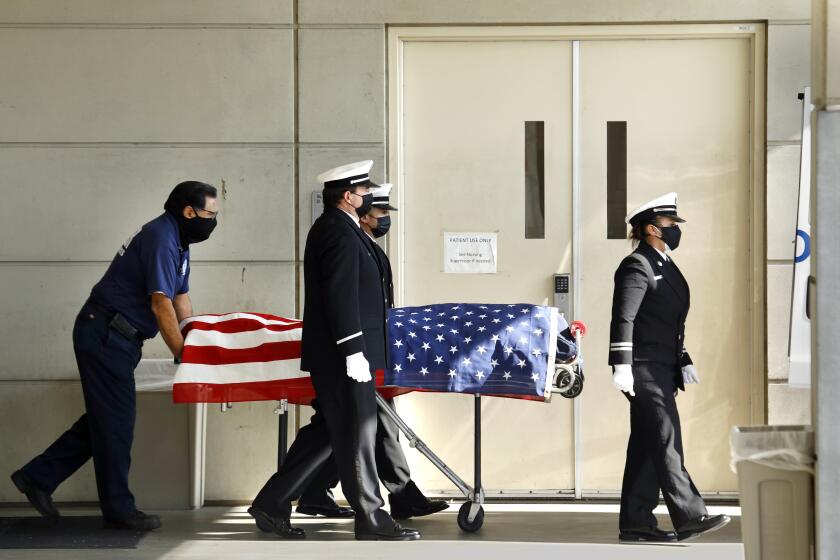‘Firefighter down’: He walked into a burning house but was carried out. What happened?
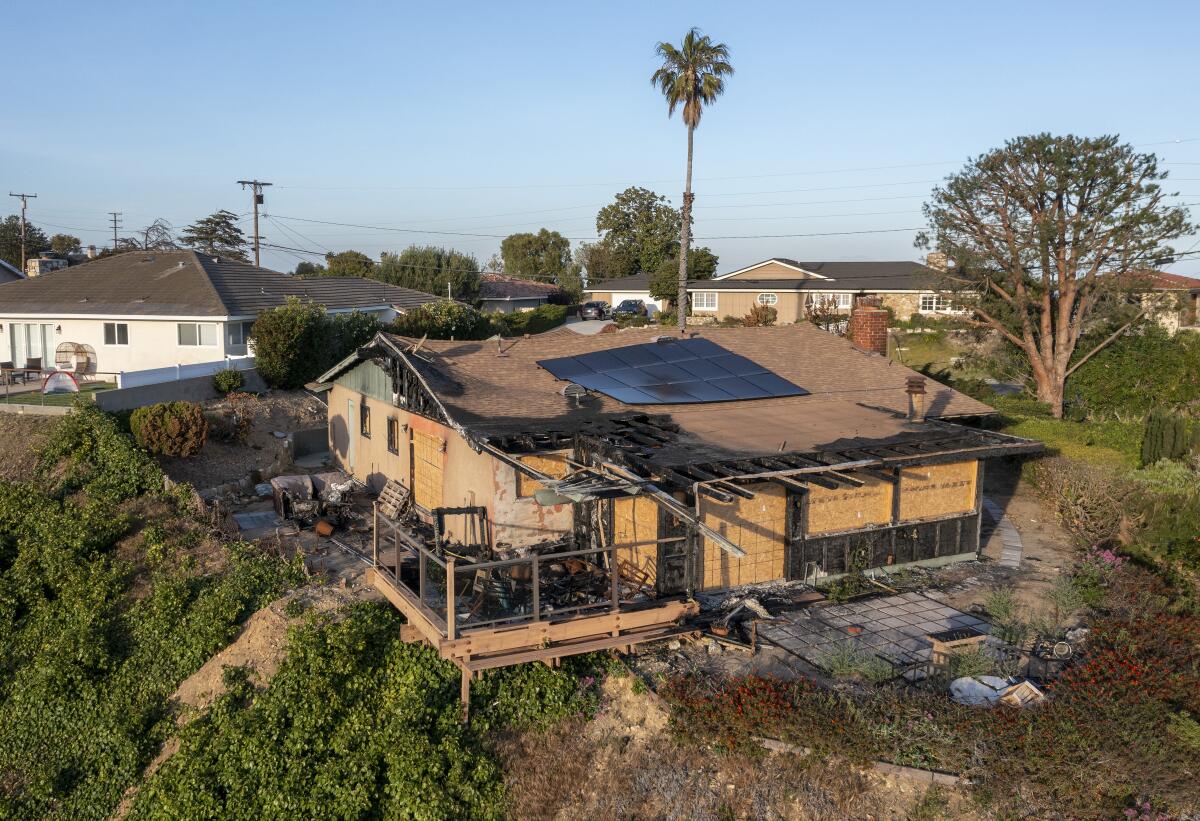
The firefighter lay unconscious in the frontyard of the burning home. His crew pulled off his soot-covered equipment and started CPR, pumping down hard with their hands on his chest, over and over again.
The ambulance was more than five minutes away.
From across Tarapaca Road in Rancho Palos Verdes, Tim Racisz watched as flames devoured his home. A neighbor counted the chest compressions — hundreds it seemed — being performed on the fallen firefighter.
“This is hopeless,” the neighbor, a doctor, told Racisz as smoke billowed. “You can’t give somebody that many compressions without just destroying them. They’re not going to come back.”
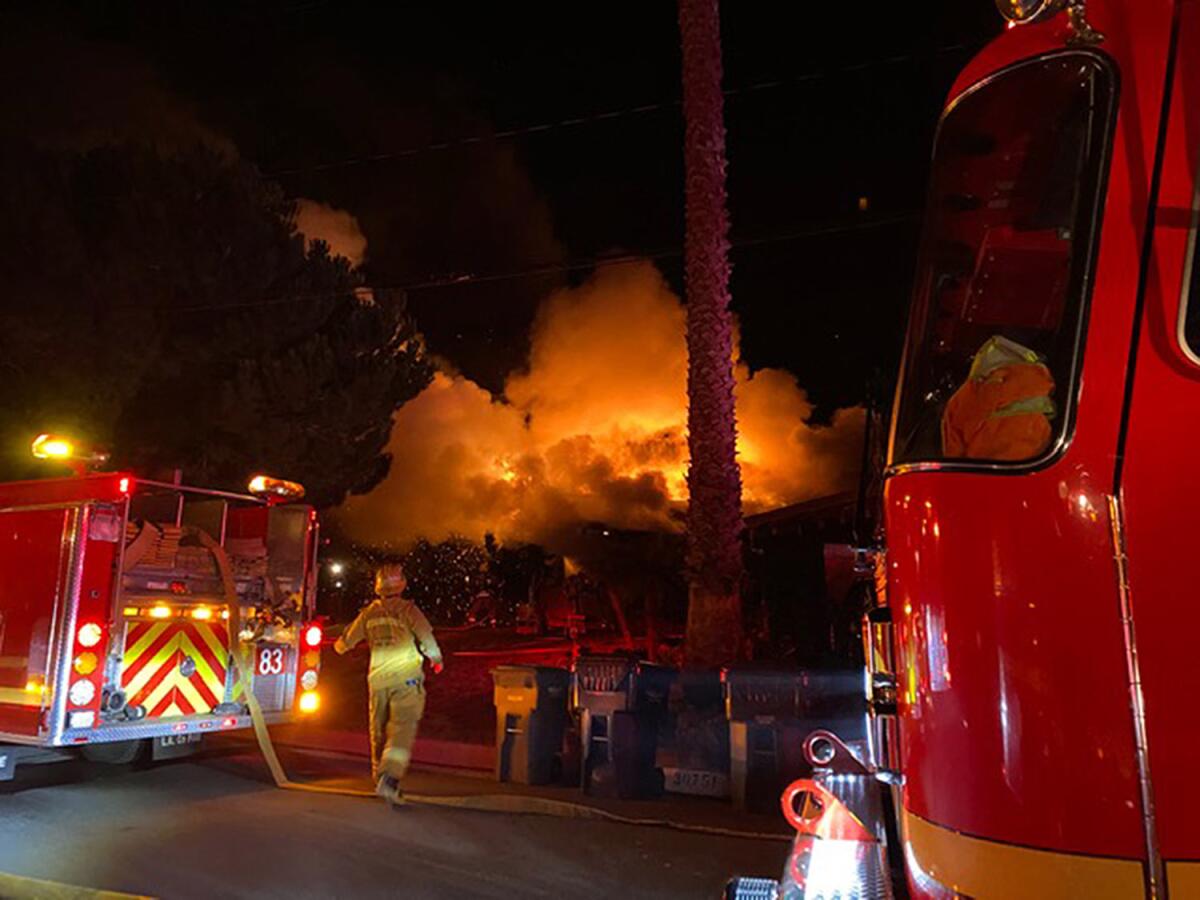
Jonathan Flagler, a 21-year veteran firefighter, never came back. The coroner later found that the father of two had suffocated. The tank in his breathing apparatus had run out of air.
Even in a place as vast and combustible as Los Angeles, Flagler’s demise represents something rare: the death of an urban firefighter battling a structure fire.
Over the last three decades, 14 members of the L.A. County Fire Department have died while on duty, according to data kept by the U.S. Fire Administration. Only three of those firefighters, including Flagler, were battling structure fires.
In a confidential report obtained by The Times, Fire Department investigators reconstructed what happened in the pre-dawn hours of Jan. 6. Relying on interviews with firefighters on the scene that night, deputies’ body-worn cameras, recordings of radio transmissions and an examination of Flagler’s protective equipment, they stitched together a minute-by-minute accounting of how the tragedy unfolded from the moment Racisz’s wife reported smoke in their four-bedroom home to the call of a “firefighter down.”
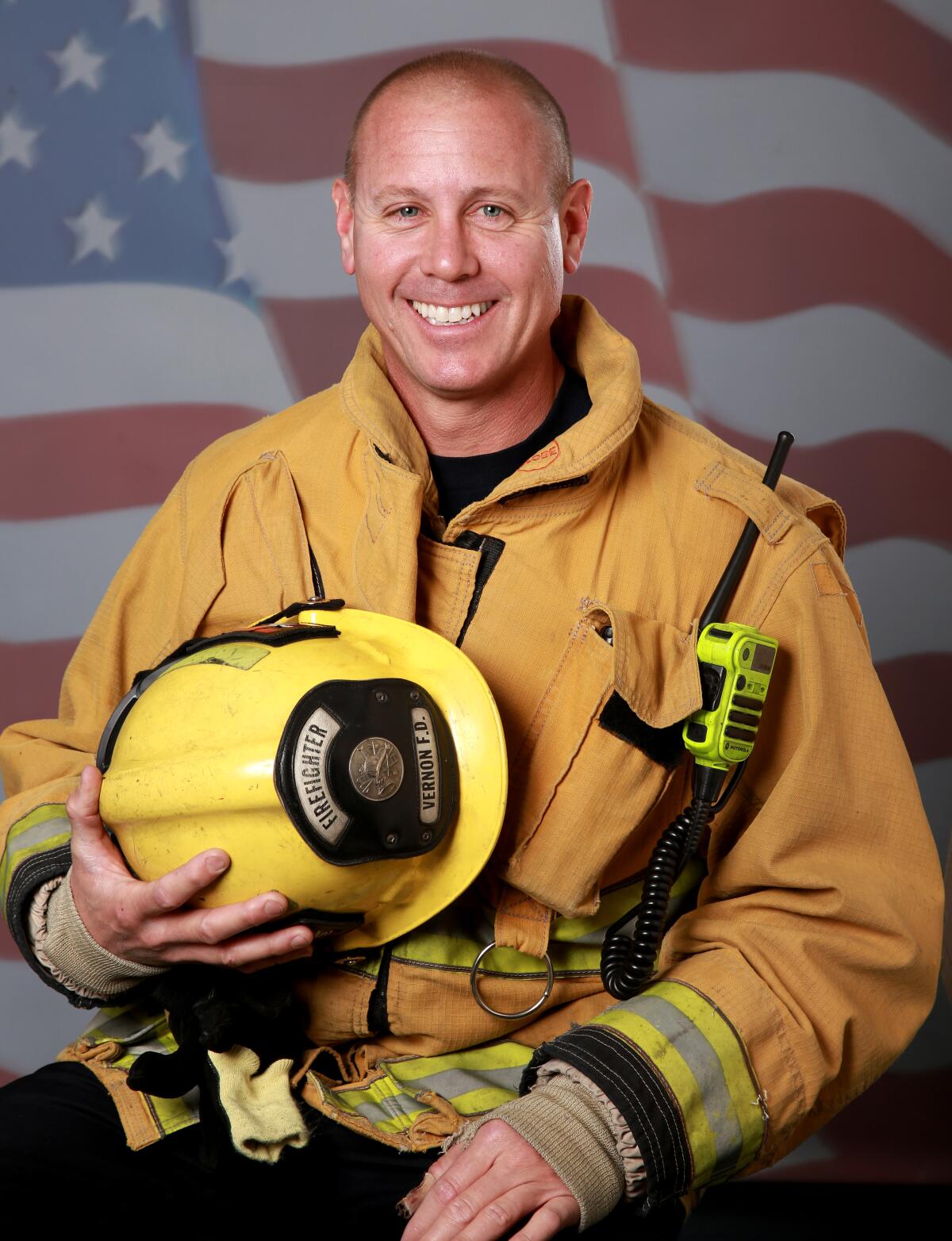
The report does not name the firefighters involved. But, combined with Racisz’s recollections, it exposes failures that cost Flagler his life. Firefighters underestimated the extent of the fire. A firefighter was left unaccounted for in a burning home. Fire crews missed a mayday call.
As the Fire Department searches for answers, so too does Flagler’s family. His death, his wife said at a memorial service, leaves a “hole in my heart that will never fully heal.”
“All it took was one date, and I knew he was the man I was meant to spend the rest of my life with,” Jenny Flagler said. “I didn’t get the rest of my life, but I got the rest of his.”
As Jonathan Flagler got dressed to leave his San Clemente home on Jan. 5 at 5 a.m., his wife asked him to call in sick.
The couple had been suffering from congestion, a cough and fatigue. Neither one knew at the time that they had COVID-19.
“I’m fine, babe, I’m going to be OK,” Flagler reassured his wife. “I’m only going to be gone one day, and then I’ll come home.”
Then he drove more than 60 miles to Fire Station 83, where he’d been employed for a year. Working there felt nostalgic for the 47-year-old. The station was where he’d participated in the Explorer Program, which introduces teenagers and young adults to careers in the fire service.

Subscribers get exclusive access to this story
We’re offering L.A. Times subscribers special access to our best journalism. Thank you for your support.
Explore more Subscriber Exclusive content.
Jenny didn’t worry when Jonathan headed there for a shift. She was concerned, she said, only when he went out on wildland fires. Those felt more unpredictable and dangerous. She’d go hours without hearing from him.
Jonathan was busy that Wednesday at the station, only able to text Jenny a couple of times. That evening, as usual, he called his wife to recap the day. The conversation was shorter than normal.
“We’ve been running calls all day. I’m tired,” Jonathan said. “I’m hoping we don’t have any calls tonight and I can get some sleep.”
His shift wasn’t scheduled to end until the next morning, around 8.
“I hope you can get some rest,” Jenny said before they hung up. “I’ll see you in the morning.”
Racisz and his wife smelled the acrid smoke before they saw the fire.
He was asleep in the bedroom while his wife watched TV in another room. As she got ready to go to bed, she caught a burning smell wafting through the more than 2,000-square-foot house on Jan. 6. Soon after, the smoke alarm woke him.
Racisz, who had lived in the wood-frame and stucco home off and on for more than 40 years, began to search the familiar rooms for the source of the smell. There wasn’t much more smoke than there’d be if you burned something in the kitchen, he said, but the awful stench seemed to permeate the house.
His search came up empty.
Racisz, 63, got dressed as his wife called 911. At 2:01 a.m., the Los Angeles Communications Center dispatched engine companies to Tarapaca Road with a text that read: “FIRE IN ATTIC, SMK CHARGING ROOM”.
Dispatch records show how Los Angeles firefighters tried to contain a burning house in Rancho Palos Verdes.
Racisz grabbed his wallet and glasses; his wife took an iPad and portfolio. They raced out, leaving the front doors open, and stood by their ivy-covered garage. Racisz couldn’t see any smoke through the darkness.
Within minutes, a truck arrived from Station 83, less than two miles away, along with sheriff’s deputies. A captain from the station, engineer, patrol firefighter and Flagler went inside to investigate and found a small fire around the back of an end table in the master bedroom. The patrol firefighter used a 2.5-gallon water extinguisher to douse the flames.
Flagler checked the wall and ceiling temperatures in the room with a thermal imaging camera. But he didn’t know that the room’s wainscoting and blow-in insulation reduced the camera’s effectiveness.
He reported no significant findings.
Around 2:10 a.m., the fire captain radioed the dispatch center to report that his team had encountered a small fire. He said they would be able to handle it with one other crew already en route. Several units were canceled.
Flagler grabbed his breathing apparatus from the engine, pressurized it and put on his face piece before going back into the house. The fire engineer soon followed suit.
They didn’t feel the heat of a fire in the master bedroom. But when turning the lights on, they saw smoke gathering along the ceiling. They opened a sliding glass door to ventilate the room and moved the California king bed to clear a path.
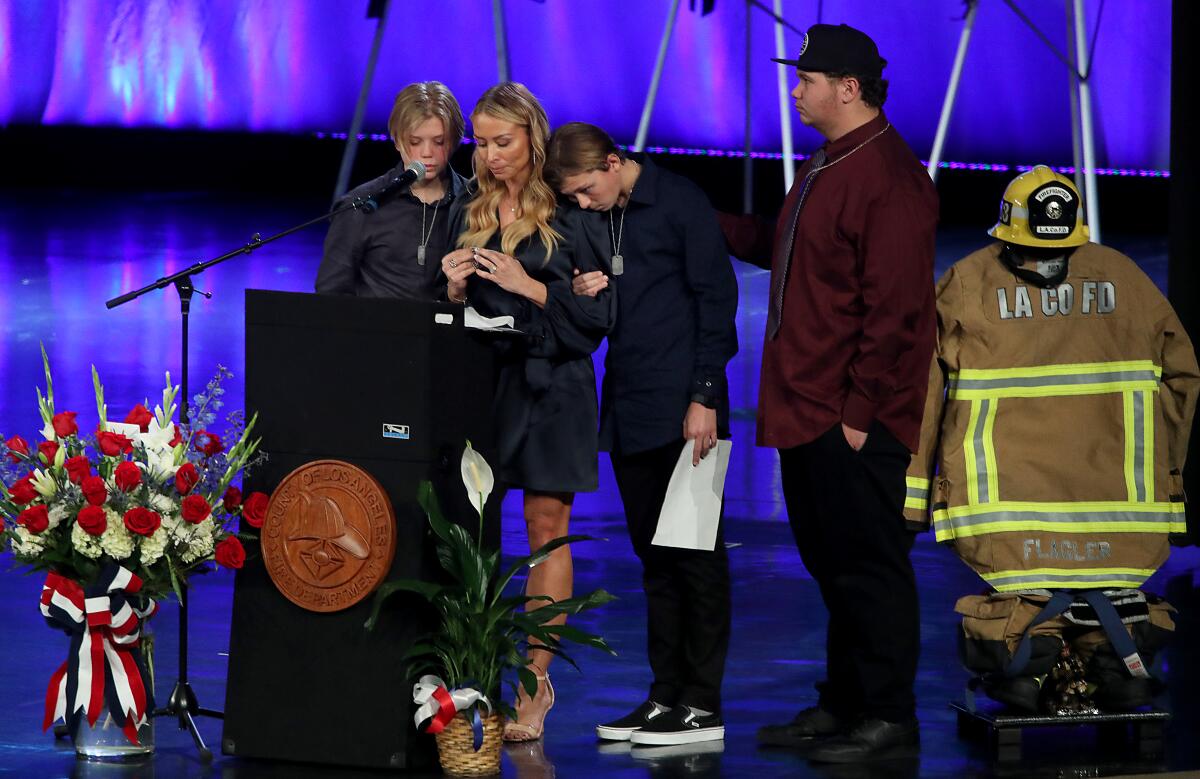
Racisz watched as one of the crew members exited the house with the smoldering nightstand. The couple was told it had been pinpointed as the source of the fire.
“We’ll show up with some fans and blow the smoke out,” Racisz recalled being told. “Things are under control.”
But Racisz hadn’t seen the nightstand on fire as the house filled with the smell of smoke and he and his wife raced to safety. It wasn’t the cause, he said, just the effect.
Soon after, inside the bedroom, the engineer spotted cause for concern: charring on the 5-foot-high ash wainscoting near an electrical outlet that could signal the fire had spread.
When a camera showed no significant thermal readings, Flagler left to grab an ax. On the front porch, he told his captain that he was going to use to the tool to check for fire in the wall.
Flagler repeatedly struck the wainscoting with the ax, finally succeeding in creating a small hole near the outlet. Inside, the crew spotted a flame licking at the base of the wall. The patrol firefighter exhausted the 2.5-gallon water extinguisher trying to put it out.
Soon, dark smoke began to spread through the house. Recognizing that they needed more water to douse the blaze, the engineer and patrol firefighter left to get a hose.
Flagler stayed behind.
Three couples huddled together across the street from the burning house.
Deputies had moved Racisz and his wife there, away from the garage. Neighbors from two houses to the south also were evacuated, for fear that the fire could spread.
“L.A., Engine 83, can you start the full assignment again?” the fire captain called over the radio at 2:23 a.m., his breathing heavy. He indicated that the engine companies that had been turned back should return to the scene of the blaze. “I do have a fire in the attic.”
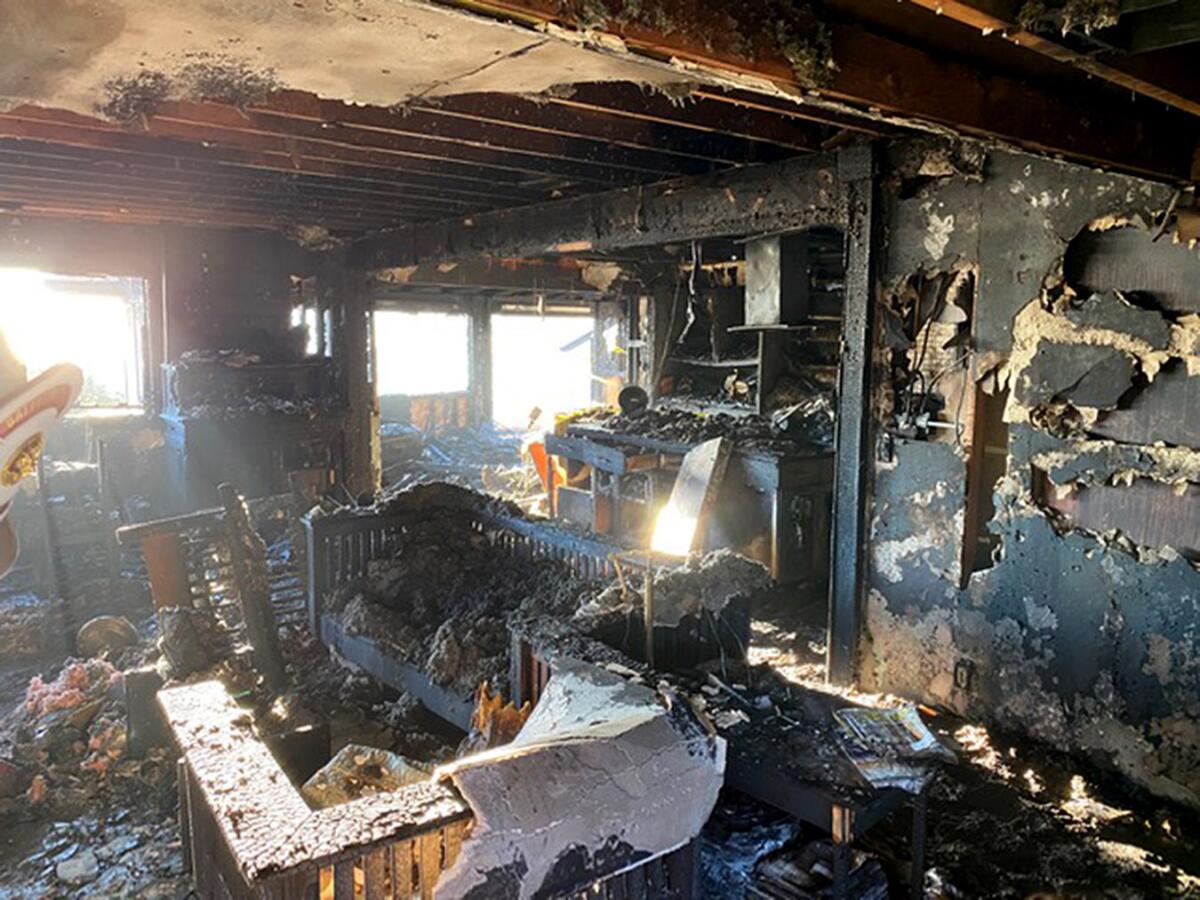
Nearby, the patrol firefighter from Flagler’s station tried to pull a hose toward the master bedroom. Heavy flames blocked his way. Meanwhile, the crew engineer dragged a hose toward the side of the house, where there was a visible glow.
Twenty-five minutes after the Raciszes called 911, a crew arrived from Fire Station 106. Crew members spotted flames climbing through the roof. Soon after, the blaze shattered a window.
Then, the alarm on Flagler’s breathing apparatus went off, warning him that he was low on air. By that time, he had been alone in the house for nearly 10 minutes.
Outside, the Engine 83 engineer pulled a hose uphill toward the nearest fire hydrant. A captain and firefighter paramedic sprayed water through the rear sliding door and window openings.
Inside, Flagler depressed and held a red button on his breathing apparatus to activate an alarm. Lights on the apparatus flashed red, and alarm tones sounded from its front and rear mounted speakers.
But there was no one else in the burning building to hear them.
It was 2:31 a.m.
A minute later, Flagler activated the emergency trigger on his radio and transmitted a mayday, alerting others that he was low on air. The corner of the house near the master bedroom was engulfed in flames.
Outside, the Engine 83 captain, Flagler’s commanding officer, was on the radio. He told dispatch: “If you haven’t started an ambulance, start one.”
He was the man tasked with his crew’s safety.
And he couldn’t hear Flagler’s cry for help.
About a mile away, a hi-lo warble tone sounded inside Engine 56, indicating there was a firefighter in distress at the scene on Tarapaca Road. The truck’s captain tried to get through to the captain from Engine 83, but couldn’t.
As the Engine 53 fire crew navigated switchbacks on Palos Verdes Drive East, where signs urged speeds of no more than 20 mph, they too heard the emergency signal. But they were still five minutes away.
At the burning home, the Station 106 captain heard the warble tone and looked around for his crew, counting heads, making sure everyone was safe. The firefighter paramedic from 106 saw Flagler’s emergency alert and told the captain that there was a man in trouble.
The report does not specify what was said. But instead of turning his attention to rescuing Flagler, the captain kept battling the fire at the back of the house.
The firefighter paramedic ran to Engine 83 to tell that captain that Flagler was low on air and the alarm had not been set off by accident.
The Engine 83 patrol firefighter — who had been in the house with Flagler but left the building — asked another crew member where Flagler was.
No one knew.
Flagler had sought shelter in a small bathroom off the hallway. His ax rested outside the door.
When the Engine 53 captain found him, the alarm on his breathing apparatus was sounding. His flashlight and thermal imaging camera were on. He was out of air, unconscious and, as the report described him, “apneic,” having temporarily stopped breathing.
The Engine 53 captain yelled for his firefighter to help him. The two moved Flagler down the hall, pulling him by the shoulder straps on his breathing apparatus. The Engine 56 captain soon joined them and helped carry the downed firefighter out the front door.
At 2:42 a.m., the crew removed Flagler’s equipment and began CPR. Racisz watched in shock from across the street.
“We have a firefighter down,” the captain from Engine 83 said over the radio. He asked when the ambulance would arrive.
At 2:54 a.m., Flagler was loaded onto a gurney and into the ambulance. He had third-degree burns over 16% of his body and broken ribs from the frantic efforts to revive him through CPR. He arrived at Harbor-UCLA Medical Center 18 minutes later.
He was pronounced dead at 3:26 a.m.
When the doorbell rang around 5 a.m., startling Jenny awake, her first instinct was to call her husband. Then it rang again. And again.
The people outside told her through the door that they were with L.A. County. Confused, Jenny wondered if there was a fire in her backyard or possibly a water leak. When she opened the door, she said, the news was evident on their faces.
She crumpled to the ground. All that moved her were the screams and cries of her two teenage sons, who had overheard the terrible news. She ran upstairs to hold them. The three fell to the ground crying.
“No, Mom, not Dad,” one son said. “Please don’t let it be Dad.”
Firefighter fatally injured while battling Rancho Palos Verdes blaze is identified as Jonathan Flagler, 47. He leaves behind a wife and two sons.
The following days passed in a blur. At Flagler’s memorial service on Jan. 21, friends, family and fellow firefighters shared stories.
To Jack, 13, Flagler was the type of father who kept Jolly Rancher candy in his truck and in his pocket to pass out to his friends, earning him the nickname “Uncle Jolly.” To Brody, he was the type of dad to trade shifts with work buddies so he could watch football with his 15-year-old son every Sunday.
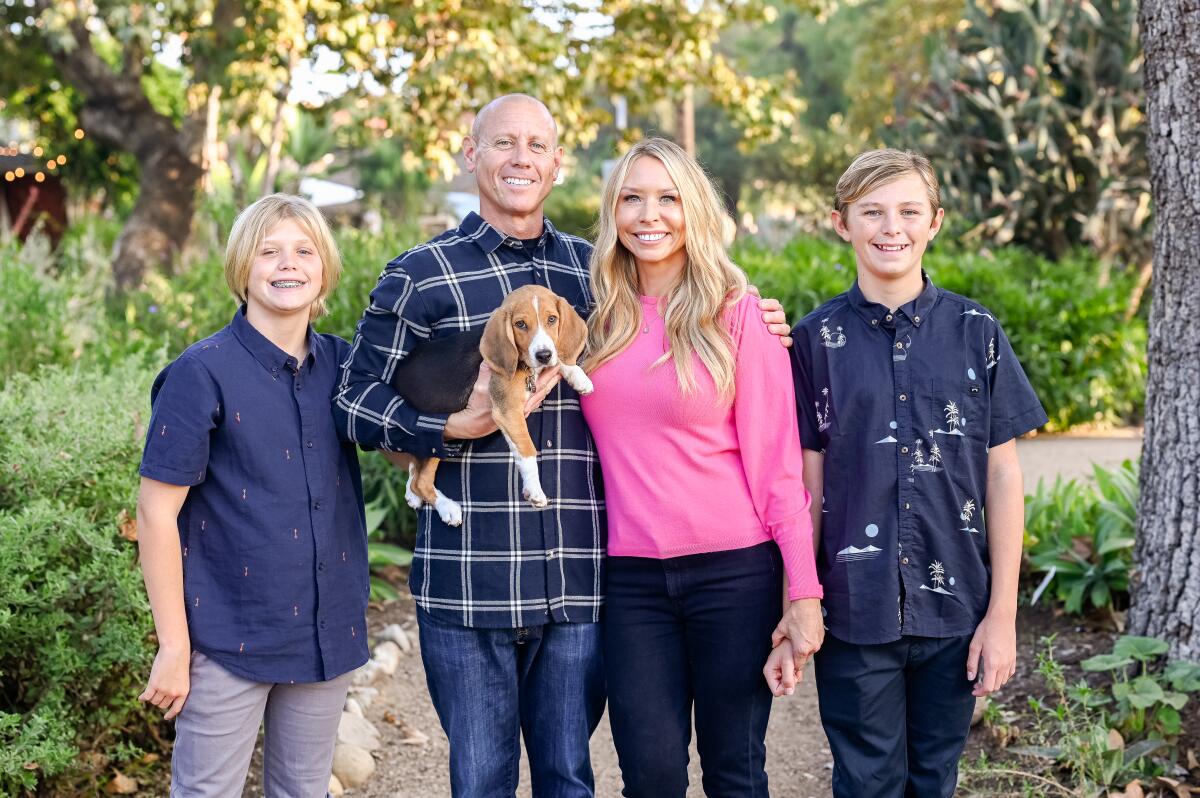
To Jenny, his wife of nearly 19 years, Flagler was her soul mate. She considered herself “one of the lucky few that found him on the first try.”
As the service neared its end, Dave Gillotte, the International Assn. of Fire Fighters Local 1014 union president and a fire captain, said Flagler “selflessly and bravely did his job well.”
“John’s legacy will carry lessons learned for his brothers and sisters,” Gillotte said.
Those lessons were painstakingly detailed in the internal report, known as a “green sheet.”
Flagged in the report were mobile radio programming problems that could cause personnel to miss emergency activations. The need for captains to be accountable over crews in the field. And having firefighters stay in teams of two or more in case of an emergency.
“Flagler was alone in an [immediately dangerous to life or health] environment after the remainder of the crew exited the structure,” the report stated. “‘Two-In, Two-Out’ rule procedures, including operating in teams of two or more, shall be implemented at emergency incidents where [immediately dangerous to life or health] conditions exist.”
Investigators found there was never a full assessment of the house’s exterior or a thorough investigation of the interior, which could have helped firefighters understand the extent of the fire.
The report found that the fire was caused by an electrical malfunction in the wall separating the master bedroom and laundry room. The fire smoldered in the wall until it burned through the plastic electrical outlet cover in the master bedroom. It then spread into the attic space and into the room, where it ignited materials around the rear of an end table.
“Personnel conducting initial investigations shall thoroughly check for and rule out all potential sources of fire before cancelling resources,” the report stated. “The readily apparent fire may not fully indicate the extent of fire.”
The fire spread out of the wall space and throughout the house, “due to construction anomalies, a significant fuel load, and natural ventilation resulting from open front double doors, an opened sliding glass bedroom door, and holes created in the wall,” the report said. Investigators recommended more training on fire dynamics, live fire and personnel accountability.
Curt Floyd, responder technical lead for the National Fire Protection Assn., does not comment on specific cases, but he noted that firefighter deaths have dropped over the years due to a number of factors. Among them are improved training and education and increased quality of protective equipment.
“We used to see firefighter fatalities in the 100s not too long ago and those have dropped down,” Floyd said. “Unfortunately, it is a dangerous job and sometimes you just don’t know what you’re getting into until you get there.”
Flagler’s family plans to file a lawsuit over his death on the job, according to an attorney representing the family. The defendants in the lawsuit have yet to be determined. The attorney declined to comment on the report.
Chad Sourbeer, a fire battalion chief, said in a statement that the department is “unable to comment on the circumstances of the Tarapaca incident due to anticipated litigation.”
But since the fire, Sourbeer said, every chief in the department has gone through training to reinforce policies and procedures and look for new opportunities to improve emergency operations. He added that there is a plan in place departmentwide for the next six months “to take those lessons and reinforce our policies and procedures with our membership.”
“The department continues to be committed to thorough reviews of major incidents, as they are an integral component in assessing how to improve emergency operations and provide better service,” Sourbeer said.
In an interview with The Times, Jenny Flagler said she doesn’t want her husband’s death to be in vain.
“What we’re going through is awful,” she said. “If I can protect any other family from having to go through this, I’m going to do everything I can.”
And that, she said, is how she plans to honor her husband.
More to Read
Sign up for Essential California
The most important California stories and recommendations in your inbox every morning.
You may occasionally receive promotional content from the Los Angeles Times.


